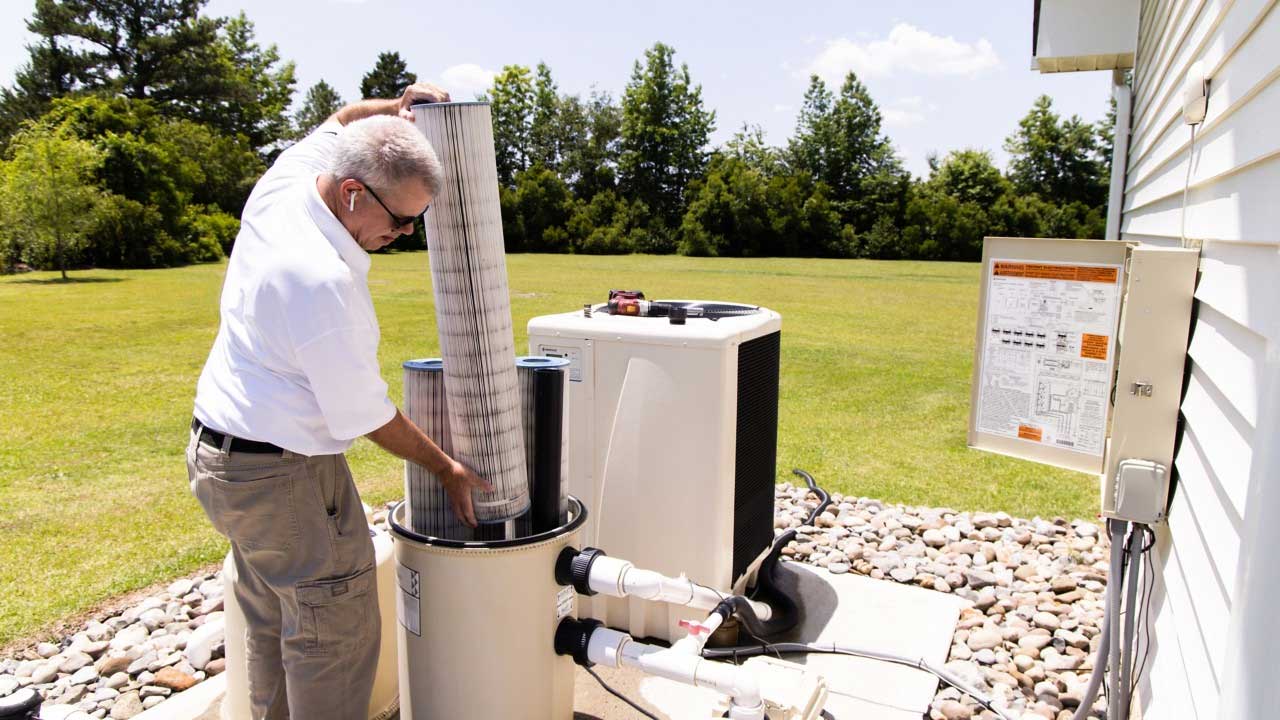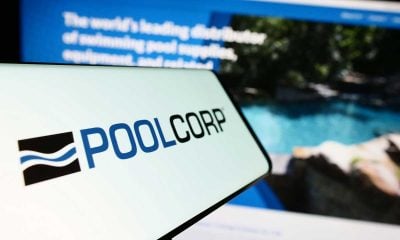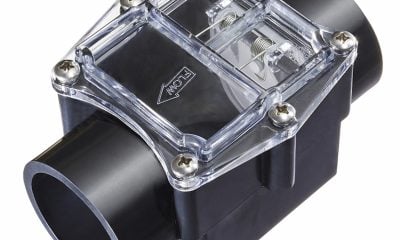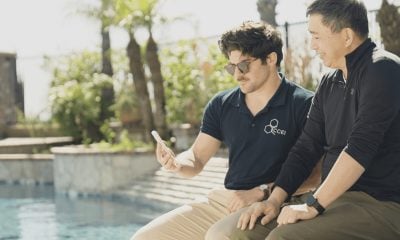Cleaning and Service Equipment and Supplies
How to Overcome Interference in Pool Water Tests

When chlorine and bromine are in excessive amounts in water, they lead to false pool water test results. In such cases, it is difficult for pool owners to identify the water’s pH and alkaline levels. Thus, drop tests, and color-matching test techniques are vulnerable to discrepancies.

Test results are not only affected by excess levels of sanitizers. Other factors could also lead to inaccurate pool water test results. Nonetheless, the leading cause of incorrect test results is the presence of excessive sanitizing agents. So, let’s find out how to fix these types of inaccuracies.
Color matching
When the sanitizing agents are more than ten or 15ppm, partial or full bleaching of DPD reagents may occur. As the pool owner, you might conclude that the pool lacks chlorine or bromine, which is not the case. The pool is, in fact, loaded with excessive sanitizing chemicals.
Therefore, if you are sure that chlorine and bromine exist in your pool, and there is no discoloration, dilute the sample and pour in the right concentration. For instance, if you have an affected sample of 10ml, lower it by 5ml, and add 5ml of pure water. Afterward, follow the test guidelines as indicated. Check the resulting color and match it with your chart to identify the pH levels. Every color in the chart is usually paired with a value. Once you determine your test value, multiply it by two to get the accurate reading.
Other interferences:
There are cases where traces of DPD are present in the test cell. This can interfere with the test results, thus ensure you cleanse test cells thoroughly before usage.
Drop test
Fortunately, drop tests can identify samples with 20ppm of sanitizing agents. But if the sanitizer is more than 20ppm, bleaching occurs and could lead to false readings. Fixing the problem entails diluting the sample with pure pool water and adding an indicator until the example achieves a pink color. Afterward, you should add a titrant until a colorless color appears. Make sure to calculate the titrant drops and double the number to get accurate results.
Other interferences:
A non-chlorine oxidizer known as monopersulfate could interfere with the combined chlorine readings. The quick chemical reaction with DPD will indicate this discrepancy. Usually, it results in an unusually high reading. To solve this problem, use a deox reagent to erase any traces of monopersulfate and perform another test.
Total Alkalinity test (drop-test technique)
When checking for the pool’s total alkalinity, ensure the pool water turns from green to red for correct results. You will know there is excessive sanitizer if the color of the water goes from blue to yellow. Suppose this is the case, get a new test sample, and add at least five drops of indicator to eradicate any excess halogen. You can then read the correct color and determine total alkalinity.
pH test
Suppose the sanitizer levels are more than 15ppm; the organic color of the indicator could become affected. You will know this because the sample color will turn purple instead of yellow or red. Once you encounter this problem, pour out the pool water from the test cell, and cleanse it thoroughly. Afterward, get another test sample from the pool and use a dipper to put in one drop of thiosulfate. The chemical thiosulfate makes the pool sanitizing agents in the sample test neutral. Once the sample becomes neutralized, put in the indicator in the test. Then, read your color against the value in the test chart. Be cautious while adding thiosulfate; you will get a false high reading when you add more than a drop of this chemical.
Other interferences:
Default or old indicators could lead to inaccurate test results. Therefore, upon purchase, ensure your indicator is far from its expiry date. But if you encounter this issue, use a fresh reagent as an alternative.
A chemical known as Poly(hexamethylene) biguanide leads to a peculiar reading when present in the sample. Even so, you don’t need to correct the test sample, the blue to yellow color change is correct. If the sample contains over 30ppm of cyanuric acid, the test results become inaccurate.
Copper/iron test
Copper tests give false readings when large concentrations of iron are in the test sample. Presuming that you encounter this type of problem, dilute the test sample and identify how much concentration of iron is in the sample. Or you can employ a digital reader to identify concentrations of copper and iron.
Calcium hardness test (drop test)
Calcium hardness tests get affected by metal ions from pipes, water, and algaecides. Some of the most common metals are copper, iron, and manganese. You will identify the presence of these metals in the test sample when there is a purple or red color. If you wish to fix the problem, get a mew sample and put in 5 -6 drops of the titrant. Afterward, add the buffer and indicator and continue with regular pool water testing.
Ultimately, don’t get shocked by false readings. From this article, you can identify what problem your pool is facing as well as fix it.
Cleaning and Service Equipment and Supplies
Streamlining Maintenance with the Right Cartridge Filter Replacement

When it comes to efficient pool maintenance, selecting the right cartridge filter replacement can have a profound impact on service schedules, inventory management, and operational costs. Cartridge filters, like those offered by Pleatco and discussed by Scott Gleason and Kevin Stewart of Pentair Pool on the Pool Magazine podcast, offer pool service professionals a way to streamline their operations.
This article aims to explore the specific time-saving benefits, how standardized cartridges simplify inventory management, the reduction in operational costs, and the advantages of replacing sand filters with cartridge systems. We will also identify the ideal pool types for cartridge filters and how Pleatco’s innovative replacements improve maintenance efficiency.
Time-Saving Benefits for Maintenance Schedules
One of the biggest challenges pool professionals face is balancing busy schedules, especially during peak seasons. Scott Gleason emphasized how the right filter cartridge can extend the time between cleaning cycles. Pleatco’s advanced cartridges feature point bonded filtration fabric and PurePleat technology, which distribute dirt evenly and reduce flow resistance over time. This means fewer service calls to clean clogged filters and quicker service when cleaning is required.
“Less frequent and quicker service events translate into fewer unscheduled visits, making it easier for pool pros to manage their time efficiently,” Gleason explained. This enhanced efficiency allows technicians to serve more clients without compromising quality.

Simplifying Inventory Management with Standardized Cartridges
Kevin Stewart highlighted how Pleatco’s cartridge design supports multiple pool brands, eliminating the need for pool pros to stock various filter types. “By standardizing cartridges, service pros save both time and money. You won’t need to maintain a large inventory of different brands, which makes things much simpler,” Stewart said.
Pleatco’s ultra-line cartridges are particularly noteworthy because they combine multiple filter functions into a single, versatile product, fitting a wide variety of pool systems. This consolidation minimizes inventory while ensuring professionals are prepared for various service scenarios.
Operational Cost Savings with the Right Filter Cartridges
Using high-quality cartridges not only saves time but also reduces operational costs. Gleason explained that opting for cheaper, lower-quality filters often leads to more frequent cleanings and service visits. “While some pool owners may focus on the initial cost, higher-quality cartridges offer long-term savings by extending cleaning intervals and ensuring optimal filtration,” Gleason noted.
Pleatco’s cartridges also help conserve water. Cartridge systems eliminate the need for backwashing, a process required with sand filters that wastes chlorinated water. Stewart pointed out, “Skipping backwashing avoids chemical loss and aligns with water conservation efforts, especially in regions with water restrictions.”
Advantages of Replacing Sand Filters with Cartridge Filtration
Cartridge filters offer several advantages over traditional sand filters. Stewart noted that “cartridge filtration delivers better water clarity by capturing particles nearly twice as small as sand filters.” Additionally, cartridge systems provide greater square footage for water filtration, reducing the frequency of cleanings.
Sand filters require frequent backwashing, which can occur weekly, while cartridge filters may only need cleaning every few months. The absence of backwashing in cartridge systems not only saves water but also simplifies maintenance, reducing downtime for pool owners.

Best Pool Types for Cartridge Filters
According to Gleason, cartridge filters are ideal for several specific pool settings:
- Residential pools with space constraints where large sand filters would be impractical.
- Saltwater pools that benefit from the fine filtration capabilities of cartridges.
- Pools in areas with water restrictions, where conserving water is critical.
- Low-usage pools that don’t require constant backwashing, making them ideal for cartridge filtration.
These filters are particularly well-suited for pools where water clarity is paramount, and maintenance needs to be minimal.
Key Features to Look for in Cartridge Filters for Extended Cleaning Cycles
| Feature | Benefit | Impact on Maintenance |
|---|---|---|
| Point Bonded Fabric | Greater dirt capture and stability | Fewer cleanings needed, extending service cycles |
| Open Flow Core Design | Reduces resistance and operating pressure | Improves water flow and filtration efficiency |
| PurePleat Technology | Prevents pleat bunching and ensures even loading | Quicker and easier cartridge rinsing |
| Universal Fit | Compatible with multiple brands | Simplifies inventory and reduces replacement time |
| Durability | Resists wear and tear | Longer cartridge life, reducing replacement frequency |

How Pleatco Cartridges Help Pool Professionals Accommodate a Busy Maintenance Schedule
With maintenance schedules becoming more demanding, especially during peak pool season, using Pleatco filters ensures service professionals can meet tight timelines. “Making an extra trip to a pool for filter cleaning can feel tedious, especially during busy times,” Gleason noted. “Pleatco’s ultra-line cartridges allow for fast and easy cleaning, which means less time spent on each service call.”
This is achieved by the combination of Pleatco’s key features—point bonded fabric, open flow core, and PurePleat technology. Together, these innovations reduce the frequency of filter cleanings and make rinsing faster when needed.
“Service techs can expect cartridge cleaning to be as simple as removing, rinsing, and replacing,” Gleason added. This streamlined process helps professionals move through their service routes more efficiently, accommodating a larger number of clients.
As an industry leader in the pool and spa space, Pentair Pool is driven to help people safely and sustainably enjoy water. Their solutions include industry-leading pumps, automation, lighting, heating, and filtration technology that help customers enjoy a smarter and more sustainable pool. Pleatco compliments Pentair’s innovative product solutions with quality and cutting-edge pool and spa filtration technology. For more information, visit www. pentair. com/pleatco.
Ready to take a deeper dive?
Listen to our entire discussion about Pleatco cartridge filter replacements with Scott Gleason and Kevin Stewart on the Pool Magazine podcast.
Cleaning and Service Equipment and Supplies
Eeziblue: A Monthly Algaecide Solution Transforming Pool Maintenance

As chlorine prices continue to soar, pool owners and professionals are increasingly seeking alternatives that maintain water quality without breaking the bank. The rising costs have led to a surge in demand for algaecide treatments, with Eeziblue standing out as a game-changer in the market. This innovative, mineral-based solution offers an efficient, cost-effective way to prevent and eliminate algae, all while significantly reducing chlorine usage.
Pool Magazine had the opportunity to discuss the product in detail with Samantha and Connor Tiegs of Eeziblue. Their insights into the product’s development, effectiveness, and unique benefits highlight why it has become a go-to option for those looking to simplify pool care while cutting down on chemical expenses.
A Product Born from Necessity: The Origins of Eeziblue
Eeziblue’s story begins in 2003 in Zimbabwe, a country where frequent power outages made traditional pool maintenance challenging. Samantha explained, “Dave, the original inventor, developed Eeziblue to address the difficulties of managing pools during outages. His goal was to create a product that could keep pools algae-free even if pumps and filtration systems weren’t running.” The product quickly gained popularity in Africa, later expanding under the Blue 52 brand in South Africa and Australia.
Today, Eeziblue has made its way to the U.S., where its affordability and effectiveness have been welcomed by pool owners and professionals. “It’s been amazing to see how well it’s taken off here,” Samantha shared. “The feedback we get from customers—both professionals and homeowners—has been incredible. They love how simple it is to use and how much they save by using less chlorine.”
How Eeziblue Works: Mineral Synergy for Cleaner Pools
At its core, Eeziblue is a “monthly pool care solution” designed to eliminate and prevent algae, while significantly reducing chlorine consumption. “Our formula uses minerals that work together with chlorine to maintain a crystal-clear swimming environment,” Connor explained. “By using Eeziblue, pool owners can cut chlorine usage by up to 75%. Instead of maintaining levels at 2 to 4 parts per million, they can drop it to just 0.5 to 1 ppm.”
This reduction not only saves money but also makes swimming more enjoyable. “It creates a softer, gentler swimming environment,” Connor added. “That’s a huge win for families who want their pool water to be easy on the skin and eyes.”
Samantha emphasized the convenience for professionals: “Eeziblue works like a multi-tool for pool maintenance. There’s no need for separate phosphate removers, clarifiers, or algaecides. Everything is handled with one product—and that simplicity makes it popular among both professionals and homeowners.”

The Science of Copper-Zinc Synergy
A key feature of Eeziblue’s effectiveness lies in what Samantha and Connor call copper-zinc synergy. “Copper is a well-known algaecide,” Connor explained, “but it has its challenges—namely the risk of staining when used at high concentrations. Zinc enhances the effectiveness of copper while also preventing it from precipitating out and staining surfaces.”
The combination allows Eeziblue to work effectively at lower concentrations. “Zinc weakens the cell wall of algae, making it easier for copper ions to penetrate,” Connor elaborated. “This means less copper is needed to get the job done. Plus, the zinc keeps the copper in solution, so it’s effective throughout the entire month.”
Maintaining the correct pH is crucial to preventing staining. “We recommend keeping the pH between 6.8 and 7.4,” Samantha said. “This ensures that the copper stays in solution and works efficiently to keep algae at bay.”
How Eeziblue Stands Out in a Crowded Market
Unlike many other algaecides that depend on constant filtration or involve expensive startup costs, Eeziblue was designed to work even in unpredictable conditions. “Because Eeziblue was originally developed in Africa, it doesn’t rely on continuous pump operation to be effective,” Samantha pointed out. “That makes it perfect for pools in areas with power outages or those looking to reduce pump run times.”
Additionally, Eeziblue’s monthly dosage system provides greater flexibility than other mineral ionizers, which often require high initial investments. “Weather is unpredictable—especially here in Houston,” Samantha explained. “A heavy storm can wash away expensive chemical treatments. With Eeziblue, you dose every month, so you’re always covered, even in unpredictable conditions.”

Subscription-Based Maintenance: Proactive Pool Care Made Easy
Eeziblue’s subscription model offers a straightforward way for homeowners to maintain their pools without hassle. “Preventing algae is much cheaper than treating it,” Connor explained. “With our subscription, homeowners receive a pre-measured dose tailored to their pool size every month. It’s a convenient reminder to apply the product and handle any routine maintenance.”
This proactive approach prevents algae from ever taking hold, saving pool owners both time and money. “Dealing with algae after the fact is time-consuming and expensive,” Samantha said. “It can take multiple trips to the pool store, and you’ll end up buying several different products. Eeziblue helps you avoid all that.”
New subscribers can try Eeziblue risk-free, thanks to a promotion that offers the first month free with no commitment. “It’s a great way to experience the benefits firsthand,” Connor added.
Green to Clean: Transforming Pools with Eeziblue
Eeziblue also excels at tackling green pools, making it a versatile tool for emergencies. “We love it when customers send us before-and-after photos of their green-to-clean transformations,” Samantha said. “The process is simple: Adjust the pH to 6.8-7.4, add Eeziblue to the skimmer basket, and follow up with a chlorine shock. In 24 hours, the algae settles at the bottom, ready to be vacuumed away.”
This fast-acting solution gives pool owners peace of mind, knowing they can quickly restore their pool’s clarity after unexpected algae blooms.

Why Eeziblue Is the Smart Choice for Pool Owners
In a market filled with algaecide products, Eeziblue stands out by offering an affordable, flexible, and easy-to-use solution. “Our product is designed to make pool care simple,” Samantha emphasized. “With Eeziblue, you don’t need to juggle multiple chemicals or worry about expensive equipment. It’s one product that covers all your needs.”
Connor reiterated the importance of proactive care: “Our goal is to help pool owners avoid costly algae problems before they even start. With Eeziblue, you only need to think about your pool once a month—and that’s all it takes to keep it crystal-clear.”
By reducing chlorine use, simplifying maintenance, and offering consistent results, Eeziblue provides a reliable solution for pool owners looking to cut costs and enjoy their pools without stress. Whether for regular upkeep or a quick fix for green water, Eeziblue makes pool care easy, effective, and economical—just what consumers need in today’s climate of rising chemical costs.
Why Pool Professionals are Turning to Eeziblue
For pool service professionals, Eeziblue offers a game-changing solution that simplifies maintenance, reduces costs, and enhances customer satisfaction. As chlorine prices remain high, many professionals are looking for innovative ways to optimize their chemical usage—and Eeziblue fits perfectly into that strategy.
“Eeziblue is the ultimate multi-tool for the back of your truck,” said Samantha Tiegs. “With just one product, pool professionals can eliminate the need for phosphate removers, clarifiers, and other specialized chemicals. It allows them to carry fewer items on their routes, which saves time and effort.”
The convenience doesn’t stop there. Eeziblue comes in bulk 40-pound buckets, making it easy for professionals to manage inventory. “Rather than lugging around multiple chemicals, one bucket of Eeziblue can treat pools efficiently all month long,” Samantha explained. Its ability to reduce chlorine usage by up to 75% also means fewer trips to replenish chlorine stock, further cutting costs.
For pool professionals interested in learning more or trying Eeziblue for themselves, the company offers bulk purchasing options and special promotions through their website. “We invite service professionals to give it a try,” Samantha said. “We’re confident that Eeziblue will become a trusted tool in their maintenance routine.”
Ready to take a deeper dive?
Listen to our entire discussion with Eeziblue on the Pool Magazine podcast.
Cleaning and Service Equipment and Supplies
The Pandemic is Over, So Why Are Chlorine Prices Still So High?

In the early months of the COVID-19 pandemic, supply chain disruptions and plant closures created a surge in chlorine prices that pool owners and service providers are still grappling with today. Many hoped that the reopening of BioLab’s plant in November 2022—a critical producer of chlorine products—would ease the strain on the market. However, almost two years later, chlorine prices remain high.
Seeking to provide clarity, this article delves into the underlying reasons why chlorine prices have not returned to pre-pandemic levels, despite expectations of relief. A combination of market dynamics, increased demand, limited supply, rising production and transportation costs, and inflation continues to exert upward pressure on chlorine prices.
What Caused Chlorine Prices to Spike?
To understand why chlorine prices remain elevated, it’s essential to look back at the events that triggered the initial spike.
The initial spike in chlorine prices can be traced back to a combination of several key factors:
1. The BioLab Plant Fire in 2020
The most significant event contributing to the chlorine shortage was a devastating fire at BioLab’s production plant in Westlake, Louisiana. The fire occurred in August 2020, shortly after Hurricane Laura swept through the area, damaging the plant. BioLab was a leading producer of chlorine tablets, and the destruction of this facility removed a major supplier from the market. With fewer producers able to meet demand, prices began to rise sharply.
2. Surge in Pool Construction During the Pandemic
The COVID-19 pandemic led to a boom in backyard pool construction, as more people sought ways to stay entertained at home. As a result, demand for chlorine soared. With more pools being built than ever before, both new and existing pool owners stocked up on chlorine to maintain their water, further exacerbating the supply crunch.
3. Panic Buying and Stockpiling
Similar to the panic buying seen with other goods during the pandemic, many pool owners and professionals began stockpiling chlorine. Uncertain of when the supply chain would normalize, consumers bought large quantities of chlorine tablets, adding more pressure to the already limited supply.
4. Supply Chain Disruptions
Global supply chain issues affected the delivery of raw materials and chemical components needed for chlorine production. Pandemic-related labor shortages, transportation delays, and increased shipping costs made it more difficult for manufacturers to keep up with demand, which in turn drove prices higher.
5. Limited Number of Chlorine Producers
Even before the fire, the pool chlorine industry was already reliant on a small number of manufacturers, with limited capacity to absorb sudden demand increases or production disruptions. With BioLab out of commission, the remaining producers struggled to fill the gap, leading to further price increases.
These factors combined to create a perfect storm, resulting in skyrocketing chlorine prices that have yet to return to pre-pandemic levels, even with BioLab back online.
Understanding Market Dynamics: A Slow Road to Stability
Although chlorine prices have eased slightly from their peak in 2022, they remain stubbornly high compared to pre-pandemic levels. Market reports indicate that prices have decreased from their all-time high, offering some relief to pool owners and service professionals. However, chlorine still costs approximately 20% more than it did before the pandemic began.

This modest dip in prices reflects a gradual recovery, yet, the market has not returned to normal. Persistent inflation, rising production and transportation costs, and increased demand for chlorine are keeping prices elevated.
While these conditions suggest that further price stabilization may be on the horizon, the 20% gap highlights the lasting impact of the pandemic-era disruptions. Many pool owners have had to adjust their budgets and explore alternatives, such as mineral-based algaecides or UV systems, to manage costs as they continue navigating higher chlorine prices.
Supply and Demand: A Pandemic-Driven Boom in Pool Construction
The pandemic triggered a surge in pool construction as people sought ways to enhance their outdoor living spaces. This increase in residential pools has led to a rise in demand for pool chemicals, including chlorine. According to industry reports, the demand for chlorine has grown steadily since 2020, putting additional pressure on manufacturers to meet consumer needs.
However, the number of companies that manufacture pool chlorine tablets is limited, leaving little room to absorb the sudden uptick in demand. Even with BioLab back in operation, the supply side of the equation is still catching up. Ongoing supply chain disruptions—ranging from shortages in raw materials to bottlenecks in logistics—have further complicated efforts to streamline production.
Additionally, chlorine producers are facing a labor crunch, with many manufacturers struggling to fill skilled positions needed to keep production lines running efficiently. As a result, it has been challenging to meet the higher demand without delays or increased costs, perpetuating high prices.
Rising Production and Transportation Cost
The cost of producing and transporting chlorine has also increased significantly, contributing to the persistent price hikes. Chlorine production is energy-intensive, and rising energy prices have driven up operational costs. Additionally, chlorine tablets require specific packaging to ensure safe handling and storage, and the cost of packaging materials has gone up as well with inflation.
Transportation costs have also increased, further impacting chlorine prices. The chemical industry relies heavily on specialized transportation to move hazardous materials like chlorine safely. Fuel costs have fluctuated over the past few years, and freight companies have raised rates due to driver shortages and higher operational expenses.
“The logistics involved in transporting chlorine are complicated and expensive,” one industry insider explained. “These costs inevitably get passed down to the consumer.”
Inflation’s Impact on Chlorine Prices
Inflation has played a major role in keeping chlorine prices elevated. In recent years, inflationary pressures have increased across nearly all sectors of the economy, from raw materials to labor and transportation. The pool industry has not been immune to these effects.
Even as some supply chain issues have been resolved, the cost of doing business has remained high. Labor costs have increased as employers offer higher wages to attract workers, and the cost of raw materials used in chlorine production has risen as well. These inflationary pressures have forced manufacturers to maintain higher prices to cover their increased expenses.

Outlook: When Will Prices Stabilize?
The chlorine market is likely to remain volatile in the near term, with no immediate relief in sight for consumers. While BioLab’s reopening was a big step in the right direction toward restoring balance in the market, the industry is still grappling with the long-term effects of the pandemic. Market stabilization will depend on several factors, including improvements in supply chain efficiency, labor availability, and energy prices.
In the meantime, pool owners and service providers will need to find ways to manage costs. Many professionals are turning to alternatives, such as mineral-based algaecides and UV sanitation systems, to reduce chlorine consumption. Others are stocking up on chlorine during off-peak seasons, when prices are slightly lower, to mitigate the impact of ongoing price fluctuations.
Industry experts predict that chlorine prices may begin to stabilize by late 2024 or 2025 as supply chains improve and inflationary pressures ease. However, with demand for pools and outdoor living continuing to grow, it is unlikely that chlorine prices will return to pre-pandemic levels anytime soon.
Main Take Aways
Despite hopes that chlorine would drop substantially in 2024, a combination of factors has kept them stubbornly high. Market dynamics, ongoing supply and demand imbalances, rising production and transportation costs, and inflation have all contributed to the persistence of elevated prices.
While there may be some long-term stabilization in the future, pool owners and service professionals will need to remain adaptable in managing their chlorine needs. Exploring alternative sanitation methods, optimizing chemical usage, and planning ahead for seasonal fluctuations can help mitigate the impact of high chlorine prices.
As the pool industry continues to evolve, the lessons learned from this period of price instability will likely shape future strategies for managing supply, demand, and production costs more effectively. Until then, consumers will need to navigate the realities of a complex and evolving market.
-

 Trade Shows1 week ago
Trade Shows1 week agoPool Trade Shows & Industry Events To Attend in 2025-2026
-

 Pool Maintenance5 days ago
Pool Maintenance5 days agoNJ Municipal Workers Accused of Stealing Pool Chemicals For Their Own Business
-

 Pool Builder2 weeks ago
Pool Builder2 weeks agoBasin Pool Designs Has The Right Recipe For Creating Spectacular Luxury Pools
-

 Pool News3 weeks ago
Pool News3 weeks agoPool Tile, Coping, and Kickflips: The Unique Lifestyle of Thiago Dasilva
-

 Industry News3 weeks ago
Industry News3 weeks agoInsights with POOLCORP Vice President of Marketing, Kendall Large
-

 Contractors and Builders2 weeks ago
Contractors and Builders2 weeks agoInsurance Premiums on the Rise: How Pool Pros Can Stay Afloat
-

 Manufacturers3 weeks ago
Manufacturers3 weeks agoLatham Pools: Driving Innovation as They Approach a Platinum Milestone
-

 News3 weeks ago
News3 weeks agoAquaStar hires Jeff Cameron as Northeast Sales/Technical Manager




































